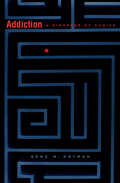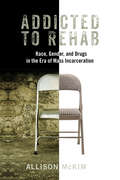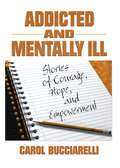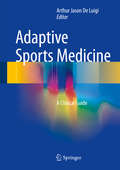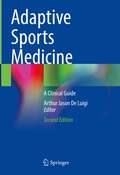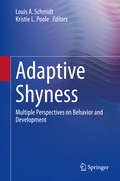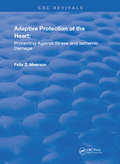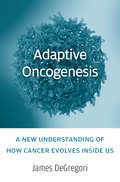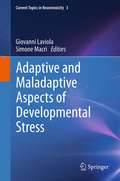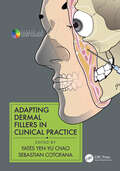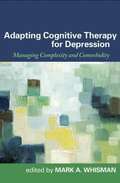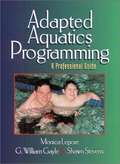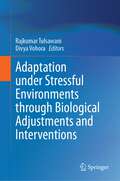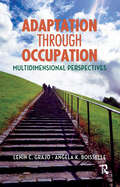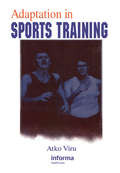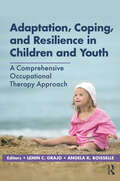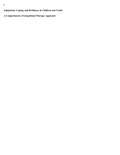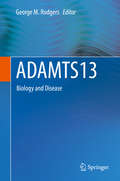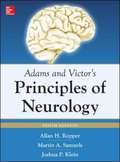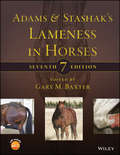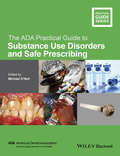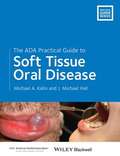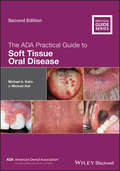- Table View
- List View
Addiction: A Disorder of Choice
by Gene M. HeymanIn a book sure to inspire controversy, Gene Heyman argues that conventional wisdom about addiction—that it is a disease, a compulsion beyond conscious control—is wrong. Drawing on psychiatric epidemiology, addicts’ autobiographies, treatment studies, and advances in behavioral economics, Heyman makes a powerful case that addiction is voluntary. He shows that drug use, like all choices, is influenced by preferences and goals. But just as there are successful dieters, there are successful ex-addicts. In fact, addiction is the psychiatric disorder with the highest rate of recovery. But what ends an addiction? At the heart of Heyman’s analysis is a startling view of choice and motivation that applies to all choices, not just the choice to use drugs. The conditions that promote quitting a drug addiction include new information, cultural values, and, of course, the costs and benefits of further drug use. Most of us avoid becoming drug dependent, not because we are especially rational, but because we loathe the idea of being an addict. Heyman’s analysis of well-established but frequently ignored research leads to unexpected insights into how we make choices—from obesity to McMansionization—all rooted in our deep-seated tendency to consume too much of whatever we like best. As wealth increases and technology advances, the dilemma posed by addictive drugs spreads to new products. However, this remarkable and radical book points to a solution. If drug addicts typically beat addiction, then non-addicts can learn to control their natural tendency to take too much.
Addicted to Rehab: Race, Gender, and Drugs in the Era of Mass Incarceration
by Allison MckimAfter decades of the American “war on drugs” and relentless prison expansion, political officials are finally challenging mass incarceration. Many point to an apparently promising solution to reduce the prison population: addiction treatment. In Addicted to Rehab, Bard College sociologist Allison McKim gives an in-depth and innovative ethnographic account of two such rehab programs for women, one located in the criminal justice system and one located in the private healthcare system—two very different ways of defining and treating addiction. McKim’s book shows how addiction rehab reflects the race, class, and gender politics of the punitive turn. As a result, addiction has become a racialized category that has reorganized the link between punishment and welfare provision. While reformers hope that treatment will offer an alternative to punishment and help women, McKim argues that the framework of addiction further stigmatizes criminalized women and undermines our capacity to challenge gendered subordination. Her study ultimately reveals a two-tiered system, bifurcated by race and class.
Addicted and Mentally Ill: Stories of Courage, Hope, and Empowerment
by Bruce Carruth Carol BucciarelliReconnect with dually diagnosed individuals using stories they can identify with! Addicted and Mentally Ill: Stories of Courage, Hope, and Empowerment is a powerful tool to recommend to your clients who are dually diagnosed. This book presents vignettes about people with mental illness and addiction whose situations are representative of what goes on in a dual-diagnosis in-patient setting. This nonclinical, easy-to-read resource will give you, your patients, and their family members unique insight on dual diagnosis and how co-occurring mental illness and addiction can be treated with the minimum amount of blame, shame, or poor decision-making. Addicted and Mentally Ill focuses on the most significant issues surrounding these individuals, such as: dual diagnosis and the family system-how family can help or hinder treatment the reasons why dually diagnosed clients resist treatment the fear of losing self-identity in treatment the misunderstandings about dual diagnosis-from the perspectives of the client, family members, and professionals in medicine and social work the role of hope, empowerment, and spirituality in recovery in dual diagnosis what the patient/client and family members can do to improve treatment options Addicted and Mentally Ill is unique for its storytelling format, consisting of brief tales and short explanations you can recommend to clients and families with limited clinical knowledge or time. This innovative tool answers many of the questions that dually diagnosed individuals may have and helps them learn of the issues surrounding their illness as well as their addiction. For those professionals who provide direct counseling to these clients or patients, this book offers an interesting and nonthreatening way to help them learn about treatment options. The stories in Addicted and Mentally Ill confront the life problems specific to dually diagnosed individuals, including: alcohol, drugs, and self-medication the difficulties of building trust in group therapy settings psychotropic medications illnesses such as bipolar disorder, schizophrenia, depression, and personality disorders suicide
Adaptive Sports Medicine: A Clinical Guide
by Arthur Jason De LuigiThis first-of-its-kind text provides a comprehensive presentation and review of the unique aspects of adaptive sports medicine and adaptive athletes, who are increasingly active and prominent, not only individually and in local leagues and organizations but also in larger settings like the Paralympics. Divided into thematic sections, part one covers the history and natural course of the care, policies and laws that have been developed over the years for persons with disabilities, as well as the biomechanics and technology of wheelchair sports and adaptive sports prostheses. The medical considerations of the adaptive athlete comprise part two, including injury epidemiology, emergent care, and surgical and rehabilitative considerations. Part three, by far the most extensive section, discusses specific wheelchair and adaptive sports, including adaptive running, cycling, water sports and throwing sports, wheelchair basketball, softball and rugby, as well as adaptive combative and extreme sports. Selected topics, including event planning, advocacy and controversies such as doping, are covered in part four. A comprehensive yet practical text, Adaptive Sports Medicine is a go-to resource and will be an invaluable reference for any sports medicine or primary medicine practitioner working with this unique population.
Adaptive Sports Medicine: A Clinical Guide
by Arthur Jason De LuigiNow in a revised and expanded second edition, this unique book provides a comprehensive review of the unique aspects of adaptive sports medicine and adaptive athletes who are increasingly active and prominent, not only individually and in local leagues and organizations but also in larger settings like the Paralympics and Warrior Games.This book is divided into four thematic sections. Section one covers the history and natural course of the care, policies, and laws for persons with disabilities, as well as the biomechanics and technology of wheelchair sports and adaptive sports prostheses. The medical considerations of the adaptive athlete comprise section two, including epidemiology, emergent care, and surgical and rehabilitative considerations. Section three is the largest section, discussing considerations for specific adaptive sports, including adaptive running, cycling, water sports, throwing sports, wheelchair basketball, softball and rugby, as well as combative and extreme sports. Selected topics, including event planning, advocacy and controversies such as doping, are covered in section four. Chapters new to this edition include approaches to concussions and sports-related considerations for specific populations like children and adolescents, active duty military and veterans. A comprehensive yet practical text, Adaptive Sports Medicine 2nd Edition remains the go-to resource for this active population and is an invaluable reference for any sports medicine or primary medicine practitioner.
Adaptive Shyness: Multiple Perspectives on Behavior and Development
by Louis A. Schmidt Kristie L. PooleThis book examines the adaptive aspects of shyness. It addresses shyness as a ubiquitous phenomenon that reflects a preoccupation of the self in response to social interaction, resulting in social inhibition, social anxiety, and social withdrawal. The volume reviews the ways in which shyness has traditionally been conceptualized and describes the movement away from considering it as a disorder in need of treatment. In addition, it examines the often overlooked history and current evidence across evolution, animal species, and human culture, demonstrating the adaptive aspects of shyness from six perspectives: developmental, biological, social, cultural, comparative, and evolutionary. Topics featured in this book include:The study of behavioral inhibition and shyness across four academic generations.The development of adaptive subtypes of shyness.Shy children’s adaptation to academic challenges.Adaptiveness of introverts in the workplace.The role of cultural norms and values in shaping shyness.Perspectives of shyness as adaptive from Indigenous Peoples of North America.The role that personality differences play on ecology and evolution. Adaptive Shyness is a must-have resource for researchers and professors, clinicians and related professionals as well as graduate students in developmental psychology, pediatrics, and social work as well as related disciplines, including social/personality, evolutionary, biological, and clinical child psychology, anthropology, sociology, and cultural studies.
Adaptive Protection of the Heart: Protecting Against Stress and Ischemic Damage (Routledge Revivals)
by Felix Z. MeersonPublished in 1991: This book explores the possibilities of protecting the heart against stress and ischemia through adaptation to intermittent hypoxia or to mild, nondamaging stress exposure. These possibilities are based on studies that show an increase in the potency and efficiency of stress-limiting systems when subjected to repeated stress actions, adaptation to high altitude hypoxia, or adaptation to increased physical loads. Any stress reaction is coupled with an activation of central and local stress-limiting systems, such as GABA-ergic, opioidergic, and serotonergic systems in the brain, as well as antioxidants, prostaglandins, and adenosine in executory organs. The book also presents the use of metabolites of stress-limiting systems rather than adaptation as a means to prevent cardiac arrythmias. It also discusses genetically determined deficiencies of stress-limiting systems and their role in the etiology of stress-induced diseases. Cardiologists and researchers studying stress and its effect on cardiovascular systems will find this book extremely useful.
Adaptive Oncogenesis: A New Understanding of How Cancer Evolves inside Us
by James DeGregori DeGregoriPopular understanding holds that genetic changes create cancer. James DeGregori uses evolutionary principles to propose a new way of thinking about cancer’s occurrence. Cancer is as much a disease of evolution as it is of mutation, one in which mutated cells outcompete healthy cells in the ecosystem of the body’s tissues. His theory ties cancer’s progression, or lack thereof, to evolved strategies to maximize reproductive success. Through natural selection, humans evolved genetic programs to maintain bodily health for as long as necessary to increase the odds of passing on our genes—but not much longer. These mechanisms engender a tissue environment that favors normal stem cells over precancerous ones. Healthy tissues thwart cancer cells’ ability to outcompete their precancerous rivals. But as our tissues age or accumulate damage from exposures such as smoking, normal stem cells find themselves less optimized to their ecosystem. Cancer-causing mutations can now help cells adapt to these altered tissue environments, and thus outcompete normal cells. Just as changes in a species’ habitat favor the evolution of new species, changes in tissue environments favor the growth of cancerous cells. DeGregori’s perspective goes far in explaining who gets cancer, when it appears, and why. While we cannot avoid mutations, it may be possible to sustain our tissues’ natural and effective system of defense, even in the face of aging or harmful exposures. For those interested in learning how cancers arise within the human body, the insights in Adaptive Oncogenesis offer a compelling perspective.
Adaptive and Maladaptive Aspects of Developmental Stress (Current Topics in Neurotoxicity #3)
by Giovanni Laviola Simone MacrìSince the very early stages of life, we all experience some form of stress. Stressors can be mild to severe and can range from unsuccessfully longing for maternal milk in infancy, to recklessly wiggling on a motorbike to be on time to watch the NBA finals on TV, to breaking up a relationship. All those events that we call "stress" have the capability of perturbing a given state of psychological and physiological equilibrium and moving it to a different level. The transition from crawling to walking has to be considered a form of stress as much as losing a job. It is through a continuous cross-talk between environmental stressors and individual adaptations that we build our personalities and our ways to cope with daily hassles. External challenges should not necessarily be regarded as "bad", but instead seen as constructive forces forming our ability to navigate a changing world. What is stress good for? What is stress bad for? When and why do we need to be "stressed"? Should we worry about stress? When does stress equate to "normality"? When does it turn into pathology? We hope with this book to provide some answers to these fundamental questions.
Adapting Dermal Fillers in Clinical Practice (Series in Cosmetic and Laser Therapy)
by Yates Yen-Yu ChaoThere have been many different brands of dermal fillers approved for use for soft tissue augmentation in the US market alone, comprising four different types of temporary fillers and one permanent type, with several other brands and types also available elsewhere in the world. Against such a potentially bewildering variety and range of choices, this new text offers a scientific and an anatomic rationale for why a particular filler should be selected as optimal for each individual location and indication and how it should best be used in treatments. International experts share their clinical knowledge and expertise to guide all levels of esthetic practitioners toward the best results for each individual patient. CONTENTS: Fundamentals of Injectable Filler Procedures * Basic Injection Techniques * Modified and Advanced Injection Techniques * Novel Injection Techniques * Esthetic Filler Injection Pearls * Adapting Injection Techniques to Different Regions * Adapting Injection Techniques to Special Indications * Adapting Injection Techniques to Different Filling Materials * Adapting Injection Techniques to Different Genders * Adapting Injection Techniques to Different Age Groups * Adapting Injection Techniques to Patients of Different Ethnicity * Prevention and Management of Complications.
Adapting Cognitive Therapy for Depression
by Mark WhismanWhile the efficacy of cognitive therapy for depression is well established, every clinician is likely to encounter patients who do not respond to "standard" protocols. In this highly practical volume, leading authorities provide a unified set of clinical guidelines for conceptualizing, assessing, and treating challenging presentations of depression. Presented are detailed, flexible strategies for addressing severe, chronic, partially remitted, or recurrent depression, as well as psychiatric comorbidities, medical conditions, and family problems that may complicate treatment. The book also offers essential knowledge and tools for delivering competent care to specific populations of depressed patients ethnic minorities; lesbian, gay, and bisexual people; adolescents; and older adults.
Adapted Aquatics Programming: A Professional Guide
by Monica Lepore G. William Gayle Shawn StevensThis text for aquatics instructors covers the various philosophies and issues relating to adapted aquatics programs; offers detailed information on skills and resources for adapted aquatics personnel; and discusses program enhancement, including model programs and how to modify fitness activities for participants with disabilities. Annotation c. Book News, Inc. , Portland, OR (booknews. com)
Adaptation under Stressful Environments through Biological Adjustments and Interventions
by Rajkumar Tulsawani Divya VohoraThe book delves into the intricate interplay of stress and adaptive responses, and their multifaceted dynamics influenced by stress type, exposure duration, genetic factors, and lifestyle elements. It unveils the complexity of stress management, unveiling how adaptive strategies evolve in response to stressors. By harnessing scientific breakthroughs in stress response comprehension, the book navigates the path to effective stress mitigation. Through avenues such as pharmacological interventions, dietary adjustments, psychological enhancement, and more, the book advocates for achieving adaptive resilience—a state where the system effectively copes with stress. The text encapsulates an array of stressors, including extreme stress, oxidative stress, and genotoxic stress, dissecting their impact on systemic equilibrium and health. The book's focal point rests on adaptive mechanisms that vary with stressor types, while also spotlighting how these mechanisms can be calibrated through pharmacological and alternative means. This is an invaluable resource for understanding, mitigating, and harnessing the power of adaptation in the face of stress-induced challenges.
Adaptation Through Occupation: Multidimensional Perspectives
by Lenin Grajo Angela BoisselleAdaptation, as an internal human process, is an often-overlooked construct in occupational therapy education, research, and practice. Adaptation Through Occupation: Multidimensional Perspectives aims to change that by presenting different perspectives that challenge the reader’s understanding of occupational adaptation. As the first of its kind text to explore, analyze, and present a comprehensive and multidimensional approach to understanding occupational adaptation, the collection of writings in this text add to the range of knowledge available in occupational therapy.Adaptation Through Occupation: Multidimensional Perspectives by Drs. Lenin Grajo and Angela Boisselle provides in-depth perspectives of occupation and adaptation that can be used to teach courses on foundational and theoretical perspectives in occupational therapy, occupational science undergraduate and graduate programs, and as a critical module in teaching Neuroscience to occupational therapy students. This text also aims to facilitate new bodies of research to define and apply the concept of adaptation in relation to occupational performance and participation.Some perspectives covered inside include: Historical and theoretical perspectives on occupation and adaptation Neural mechanisms of occupational adaptation Occupational science perspectives and international and lived-experience perspectives Included with the text are online supplemental materials for faculty use in the classroom.Adaptation Through Occupation: Multidimensional Perspectives opens the gates for new ways of understanding occupational adaptation and adds necessary information to the existing knowledge in the occupational therapy profession.
Adaptation in Sports Training
by Atko ViruFounded on an analysis of scientific literature and backed by an abundance of references, this timely new book examines problems related to sports training, as well as the concept that training-induced changes are founded on adaptive protein synthesis. Discussions include:Alterations in the organism's adaptivity during exercise trainingIntracellular control of protein synthesis points on molecular mechanisms in exercise trainingEndocrine mechanisms with regard to acute adaptation during exercise, as well as amplification and post-translation control of the adaptive protein synthesisPractical benefits of the adaptation process in training
Adaptation, Coping, and Resilience in Children and Youth: A Comprehensive Occupational Therapy Approach
by Lenin Grajo Angela BoisselleA groundbreaking text for occupational therapists, Adaptation, Coping, and Resilience in Children and Youth: A Comprehensive Occupational Therapy Approach offers a different perspective in addressing the ways children and youth with a variety of conditions and personal contexts can have more optimized participation in everyday life. This text is essential for occupational therapy graduate students, instructors, and pediatric clinicians.Drs. Lenin C. Grajo and Angela K. Boisselle provide a comprehensive, strength-based approach in addressing the ability of children to adjust to a variety of challenges encountered in daily life across multiple environments and contexts. Adaptation, Coping, and Resilience in Children and Youth includes best and evidence-based practices for assessment and intervention.Included in the book: Collaborative approach with families How to build relationships through interprofessional collaboration (teachers, health care team, and community) Global perspectives of adaptation, coping, and resilience Case applications and essential considerations for occupational therapists The text also covers underexplored contexts such as those who have been bullied, children and youth who are LGBTQ and gender expansive, children and youth of color, those who live as a member of a migrant family, and those who have lived with and through adverse childhood experiences.Adaptation, Coping, and Resilience in Children and Youth: A Comprehensive Occupational Therapy Approach is a necessary text that offers timely best and evidence-based practices for assessment and intervention for occupational therapy students and professionals.
Adaptation, Coping, And Resilience In Children And Youth: A Comprehensive Occupational Therapy Approach
by Lenin C. Grajo Angela K. BoisselleA groundbreaking text for occupational therapists, Adaptation, Coping, and Resilience in Children and Youth: A Comprehensive Occupational Therapy Approach offers a different perspective in addressing the ways children and youth with a variety of conditions and personal contexts can have more optimized participation in everyday life. This text is essential for occupational therapy graduate students, instructors, and pediatric clinicians.
Adamts13: Biology and Disease
by George M. RodgersThis comprehensive volume discusses the protease ADAMTS13, summarizing the current status of basic and clinical research. The nine authoritative chapters begin with a historical perspective followed by exploration of the biochemistry and structure-function relationships of ADAMTS13 as well as its normal function in hemostasis (cleavage of von Willebrand factor). Emerging research themes for ADAMTS13 are covered, including its potential role in angiogenesis and other aspects of cell biology. Additional topics include laboratory assays for ADAMTS13, inherited ADAMTS13 deficiency, and acquired ADAMTS13 deficiency. A chapter on related thrombotic microangiopathic (TMA) disorders examines the differences between TMAs associated with ADAMTS13 deficiency and those not associated with ADAMTS13 deficiency. A final chapter reviews the preliminary information on emerging aspects of ADAMTS13, such as the status of recombinant ADAMTS13 products and their potential utility. Comprehensive in its exploration of the ADAMTS13 protease in disease, ADAMTS13: Biology and Disease is a significant resource for clinical hematologists, transfusion medicine physicians, and researchers interested in hemostasis, vascular biology, biochemistry, and metalloproteases.
Adam's Daughter
by Jennifer TaylorThe doctor's secret child Nurse Elizabeth Campbell had promised her sister she would never reveal her baby's identity to its father. But now Beth has Hannah in her care and the child is in need of her father's help. Beth knows she must find him.Dr. Adam Knight is furious that no one told him he had a daughter, and now he's determined to be involved in Hannah's life. But he'll also be in Beth's life--fueling their unexpected attraction. An attraction that Beth wants to resist because she fears that Adam's real feelings are not for herself--but for her sister!
Adams and Victor's Principles of Neurology (Tenth Edition)
by Allan Ropper Martin Samuels Joshua KleinThe definitive text on the full-spectrum of neurology for decades, Adams and Victor's provides the treatment and management strategies needed to confidently handle both common and rare neurologic conditions. Written in a clear, consistent tone, this classic resource will meet the needs of the seasoned professional or the aspiring clinician. Written from the perspective of the general neurologist, Adams and Victor's has been hailed as the most detailed, thorough, and authoritative text available on the subject. Adams and Victor's Principles of Neurology, Tenth Edition describes the various categories of neurologic disease and the main diseases that constitute each. Each subject is introduced by a detailed discussion of the symptoms and signs of disordered nervous function, their anatomic and physiologic bases, and their clinical implications. Adams and Victor's Principles of Neurology is logically divided into six parts: The Clinical Method of Neurology Cardinal Manifestations of Neurologic Disease Growth and Development of the Nervous System in the Neurology of Aging Major Categories of Neurologic Disease Diseases of the Spinal Cord, Peripheral Nerve, and Muscle Psychiatric Disorders The Tenth Edition is highlighted by the welcome addition of full-color photographs, expanded coverage of important subspecialties, and an increased number of tables and figures. Edition after edition, Adams and Victor's has stayed true to its original mission: to provide a well-written, readable text emphasizing a disciplined presentation of clinical data and lucid descriptions of underlying disease processes.
Adams and Stashak's Lameness in Horses
by Gary M. BaxterProvides a fully updated Seventh Edition of the classic gold-standard reference on equine lameness This new edition of the go-to resource for equine lameness features updates throughout and more in-depth information on objective lameness assessment, sports medicine, rehabilitation, treatment options, and advanced imaging. With contributions from the world’s leading authorities on the subject, the book covers functional anatomy, examination, imaging, lameness of the distal limb, proximal limb, and axial skeleton, principles of musculoskeletal disease, therapies, occupation-related conditions, lameness in young horses, and farriery. More than 1,700 images support the text, making it an exhaustive reference for all aspects of lameness in horses. Now in its seventh edition, Adams and Stashak’s Lameness in Horses continues to be the definitive resource on equine lameness for veterinary specialists, practitioners, interns, residents, and students alike. The book is supplemented with a companion website offering a plethora of “how-to” videos demonstrating lameness examination and select perineural and intrasynovial anesthesia techniques. Offers a fully revised new edition of the classic text on equine lameness Includes more extensive information on objective lameness assessment, sports medicine, rehabilitation, treatment options and advanced imaging Features over 1,700 images to illustrate the concepts described Written by internationally renowned experts in the field Includes access to a companion website with "how-to" videos Adams and Stashak’s Lameness in Horses is a must-have reference for any practicing large animal and equine veterinarian, equine veterinary specialist, or veterinary student dealing with lameness in the horse.
The Adam Experiment
by Geoffrey S. SimmonsCortney is both scientist and mother in a dramatic experiment that turns into nine months of terror when the Alien arrives - the first human child conceived and born in space!
The ADA Practical Guide to Substance Use Disorders and Safe Prescribing
by Michael O'NeilDentists have been inundated by patients with an array of complicated medical conditions and pain/sedation management issues. This is in addition to a variety of legal regulations dentists must follow regarding the storage and recordkeeping of controlled substances. Avoid unknowingly putting your practice at risk by becoming victim to a scam or violating a recordkeeping requirement with The ADA Practical Guide to Substance Use Disorders and Safe Prescribing. This Practical Guide is ideal for dentists and staff as they navigate: * Detecting and deterring substance use disorders (SUD) and drug diversion in the dental office (drug-seeking patients) * Prescribing complexities * Treating patients with SUD and complex analgesic and sedation (pain/sedation management) needs and the best use of sedation anxiety medication * Interviewing and counselling options for SUD * Federal drug regulations Commonly used illicit, prescription, and over-the-counter drugs, as well as alcohol and tobacco, are also covered. Special features include: * Clinical tools proven to aid in the identification, interviewing, intervention, referral and treatment of SUD * Basic elements of SUD, acute pain/sedation management, and drug diversion * Summary of evidence-based literature that supports what, when and how to prescribe controlled substances to patients with SUD * Discussion of key federal controlled substance regulations that frequently impact dental practitioners * Checklists to help prevent drug diversion in dental practices * Chapter on impaired dental professionals * Case studies that examine safe prescribing and due diligence
The ADA Practical Guide to Soft Tissue Oral Disease
by J. Michael Hall Michael A. KahnThe ADA Practical Guide to Soft Tissue Oral Disease is the perfect tool to aid in identifying, diagnosing and treating soft tissue oral disease in everyday clinical practice. Focusing on the clinical aspects of management required by the general dental team, this book expertly guides readers through screening examinations, description and documentation, differential diagnosis, and guidelines for observation and referral.Ideal as a clinical handbook or review guide, The ADA Practical Guide to Soft Tissue Oral Disease is replete with color photos, case studies and discussion, and synopses of best current treatments based on up-to-date literature. Section 1 includes basic information of how to most effectively and efficiently perform a complete and thorough head and neck soft tissue screening examination. Section 2 presents an overview of the top 40 oral soft tissue lesions, as well as several less common but life?-threatening conditions such as oral cancer and infections. Section 3 is composed of a series of brief patient clinical scenarios with diagnostic exercises for self?-test and evaluation by providing discussion of the correct diagnosis and distractors.
The ADA Practical Guide to Soft Tissue Oral Disease (ADA Practical Guide)
by Michael A. Kahn J. Michael HallThe ADA Practical Guide to Soft Tissue Oral Disease, Second Edition is a fully updated new edition of this popular guide to oral and maxillofacial diseases likely to be encountered in general or specialist dental practices. Easy-to-use, updated resource with brief synopses for everyday clinical reference Includes self-testing clinicopathologic exercises to help readers further their skills and gain confidence in their knowledge Focuses on decision making, from communicating diagnoses to developing and discussing treatment plans Presents clinically oriented information on the most important aspects of common oral and maxillofacial diseases Features detailed color illustrations, treatment algorithms, differential diagnosis, and case examples with discussion
